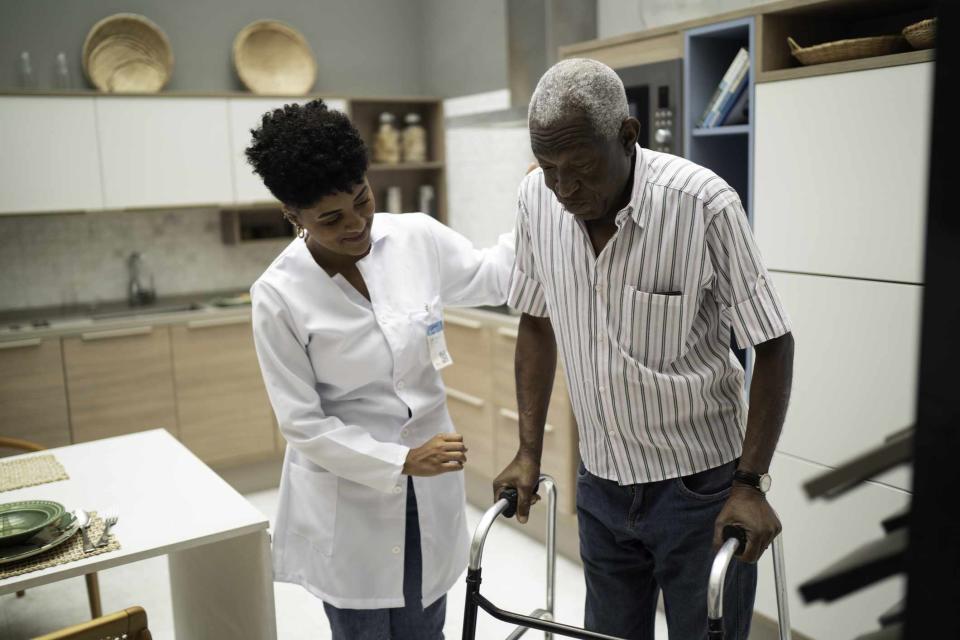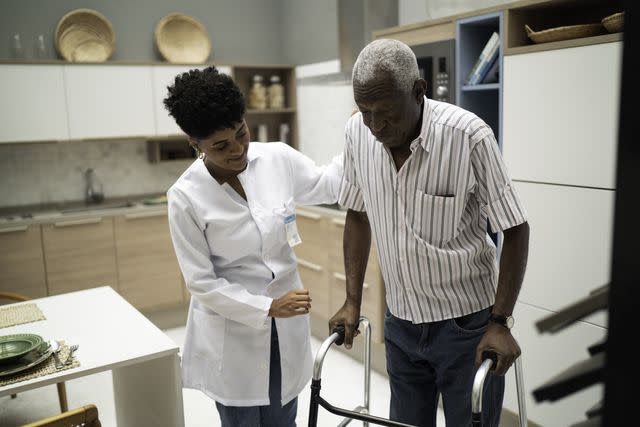Spinal Cord Injury: Emergency Signs and Long-Term Care
It can occur suddenly

FG Trade / Getty Images
Medically reviewed by Oluseun Olufade, MD
A spinal cord injury is a serious type of injury that can cause paralysis of the arms, legs, or both, on one or both sides of the body. Traumatic accidents and falls may lead to spinal cord injury. Prompt emergency treatment and rehabilitation are crucial aspects of managing spinal cord injuries for optimal recovery.
This article describes the types, causes, effects, and treatments of spinal cord injuries, as well as how to obtain the support you might need.

FG Trade / Getty Images
Common Spinal Cord Injury Causes
The spinal cord is an organized collection of nerve tracts that run in the vertebral column (spinal column). Spinal cord injuries usually occur along with other serious injuries, which may involve spinal fractures, abdominal injuries, or head injuries.
In general, the biggest risk factor for spinal cord injury is participating in high-risk activities, such as high-impact contact sports, horse racing, or car racing. Work that poses a risk of these types of injuries includes military combat, law enforcement, and heavy construction.
However, while there are activities associated with an elevated risk, anyone can experience a spinal cord injury. These injuries can occur due to multiple causes, such as birth injuries, motor vehicle accidents, falls, or progressive spine disease.
Spinal cord compression is a type of injury that can happen if a tumor, blood, or vertebral bone compresses the spinal cord.
Dos and Don’ts After Spinal Cord Injury
If you or someone else has had a serious fall or injury, it’s important to avoid movement. Moving someone who has injured their spinal column or spinal cord can lead to serious damage.
Call 911 to get emergency medical assistance. A rescue team will be able to stabilize you and immobilize your neck and back to avoid any further injury to your spinal cord as they move you to an ambulance.
Trauma to Spinal Sections: Effects of Spinal Cord Injury
The spinal cord runs from the base of the skull down to the lower back. A spinal cord injury can occur at any of these levels, with effects corresponding to the level of the injury. Typically, a spinal cord injury leads to diminished function or complete loss of function below the level of the injury.
Some effects that can occur include loss of bowel and bladder control, weakness, and loss of sensation. The muscles can be flaccid (flabby, with low muscle tone) shortly after an injury, and then they can become stiff and spastic months after a spinal cord injury.
Cervical Spinal Cord
The cervical spinal cord is the upper part of the spinal cord that runs from the base of the skull down the neck to the upper back. An injury at this level may cause severe consequences, potentially leading to paralysis of the arms, chest, trunk, and legs.
Thoracic Spinal Cord
The thoracic spinal cord is located in the mid and upper back. An injury at this level will usually cause symptoms affecting the trunk, chest, and legs.
Lumbar Spinal Cord
The lumbar spinal cord is in the lower part of the back. An injury to this region will cause symptoms affecting the legs.
Testing After a Spinal Cord Injury
Your healthcare team will promptly evaluate your movement, reflexes, and sensation if it appears that you’ve had a spinal cord injury. This can quickly identify the level of the spinal cord where the injury occurred. It can also determine whether it was a partial injury, affecting only a portion of the spinal cord, or whether the injury affected the entire cross-section of your spinal cord.
You will likely need to have imaging of your spinal cord after you are medically stable.
Spinal Cord Injury Symptoms
A spinal cord injury causes effects that correspond to the damaged areas of the spinal cord. A cross-section of the spinal cord contains nerve tracts that control muscle movement, coordination, sensation, and function of internal organs (such as the lungs, stomach, and bladder).
Common effects of a spinal cord injury include weakness and sensory loss. Additionally, autonomic dysfunction can occur—irregularity of blood pressure, heart rate, digestion, body temperature, sweating, and bladder control.
Types of Weakness or Paralysis From Spinal Cord Injury
Types of weakness or paralysis after spinal cord injury include:
A partial or incomplete cord injury may cause hemiplegia, which is paralysis of one side of the body.
A complete spinal cord injury at the level of the cervical spinal cord can cause quadriplegia, which is complete paralysis of the arms, legs, and trunk.
Paraplegia, which is complete paralysis of the legs, may occur after a thoracic or lumbar spinal cord injury.
Hemiparesis, paraparesis, and quadriparesis are partial weakness rather than complete paralysis in the affected areas.
Incomplete Spinal Cord Injury
Incomplete spinal cord injuries cause damage to a portion of the cross-section of the spinal cord and do not extend all the way across the spinal cord. This may affect movement or sensation on one side of the body below the level of the spinal cord injury. An incomplete spinal cord injury does not completely disrupt sensation and movement at the level of the injury.
Complete Spinal Cord Injury
A complete spinal cord injury affects the whole cross-section of the spinal cord at a particular level. For example, a complete spinal cord injury in the upper thoracic spine affects all motor and sensory functions at and below the injured level in the thoracic spine.
Treatment for Different Spinal Cord Injuries
The immediate treatment for spinal cord injury is directed at reducing the permanent impact of the injury. The initial loss of ability after a spinal cord injury often reflects the long-term effects. However, sometimes people experience partial or substantial recovery after a spinal cord injury. This is especially true if treatment is initiated promptly.
Treatments may include the following:
Physical stabilization of the spine can prevent pressure on the spinal cord. This may include a cervical neck collar.
Reducing inflammation and swelling may involve high-dose steroid treatment.
Surgical removal of blood, bone fragments, or materials that are pressing on the spinal cord can help optimize healing.
Antibiotics may be necessary to prevent an infection if there’s an open wound.
For severe open injuries, surgery may be needed to repair torn meningeal lining and reduce cerebrospinal fluid leaking.
In addition to these treatments, interventions may be needed to care for other injuries. For example, lung surgery or brain surgery might be necessary as well.
Experimental therapies for spinal cord injuries may include nerve transplantation or stem cell therapy. You can ask your healthcare provider to point you toward experimental therapies if you want to explore these options.
Related: Paralyzed Patients Are Walking Again After Spinal Cord Stimulation
Spinal Cord Injury Rehabilitation
You can expect to have a degree of recovery after a spinal cord injury. The extent of your recovery can vary, with some people achieving complete or almost complete recovery and others remaining severely and permanently disabled.
You and your healthcare team will discuss expectations, such as whether you can anticipate being able to use your arms, walk, or participate in sports or challenging physical activities after a spinal cord injury.
Rehabilitation involves testing your level of ability and working towards improvement to the maximum ability possible. Working toward recovery is an ongoing process after a spinal cord injury.
Rehabilitation includes physical therapy for strengthening physical movements and training to help maintain functions of eating, swallowing, breathing, urination, and having a bowel movement.
Sexual Function After a Spinal Cord Injury
Sometimes spinal cord injury affects sexual function. Your healthcare team will not usually be able to predict the extent of permanent damage in the immediate aftermath of a spinal cord injury. Rehabilitation directed at regaining sexual function, as well as medication for sexual dysfunction, can be beneficial.
Spinal Cord Injury Mobility Devices
Devices for living with spinal cord disability are varied. Some assistive tools are used to help you move from place to place, while other devices are important for helping you maintain your overall health. Depending on your specific abilities, your healthcare team may recommend different medical equipment.
Some devices you might use due to spinal cord injury include:
Spirometer to help you expand your lungs as you breathe while following the parameters that are set for you by your healthcare team
Wheelchair, which may include electronic or mechanical controls
A walker if your impairment is not severe
Splints to prevent your ankles, wrists, or other areas of your body from remaining in a flaccid position
Bedpan if you are unable to get to a toilet
Urinary catheter if you are unable to control your urine
Additionally, you may need to receive medications and nutrition through a feeding tube or intravenously (through an IV) if you are unable to swallow.
Spinal Cord Injury Disability Benefits
If you are living with the long-term effects of a spinal cord injury, you may qualify for certain disability benefits.
This may depend on several factors, such as:
The impact of the injury and the extent of your disability
Your age at the time of the injury
Whether you incurred the injury while in the military
If the injury occurred while you were working
You need to make sure that you obtain all benefits that you are entitled to. Most people are not familiar with the process of obtaining disability benefits.
It’s important that you understand that you do not have to seek out the benefits that you’re entitled to all by yourself. You can get assistance from your social worker, healthcare team, human resources at your work, government programs, or an attorney.
Related: How to Apply for Social Security Disability (SSDI) Benefits
Resources for Patients in Spinal Cord Injury Recovery
A variety of resources are available for you to help improve your quality of life. You can start by asking your healthcare providers for recommendations.
In addition to government programs, you can also benefit from online or in-person support groups. A support group can provide a sense of community, empathy, and practical advice about living well with spinal cord injury.
Summary
A spinal cord injury can be life altering. Spinal cord injuries may be partial, affecting only a portion across the spinal cord at one level, or they may be complete, affecting a whole level of the spinal cord.
The impact of a cervical spinal cord injury or a complete spinal cord injury is often more substantial than the impact of an injury that is partial or at a lower level of the spinal cord. Prompt treatment plays a crucial role in preventing severe and permanent damage.
Rehabilitation and assistance in obtaining disability benefits are necessary to help you stay as safe and healthy as possible.

